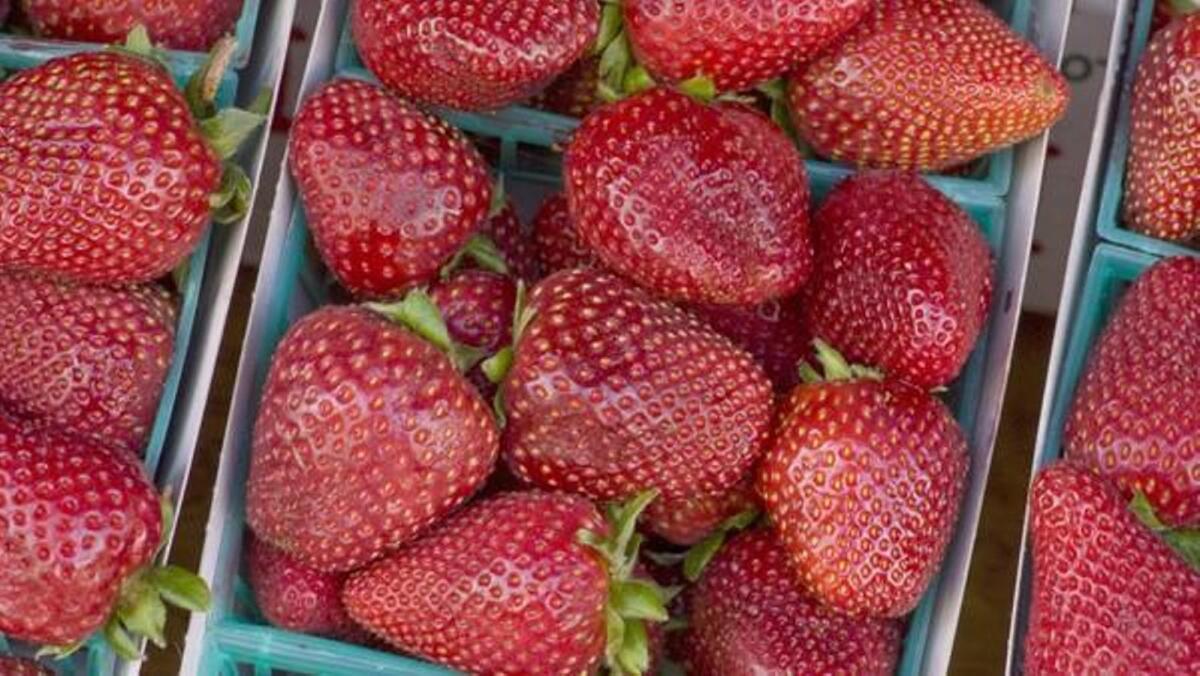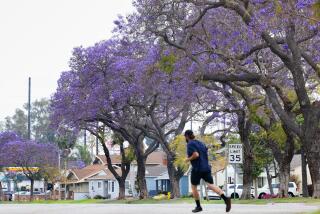Market Watch: When and how to buy strawberries

Super-sweet Gaviota strawberries are among the varieties hitting their peak at Southern California farmers markets.
- Share via
Strawberries available practically year-round are emblematic of Southern California farmers markets, but figuring out which ones to buy, when and from whom is tricky, and the subject of frequent discussion, even controversy, among market aficionados.
Seasonal timing is a primary determinant of fruit quality. If everything goes right, berries grown in November through January can be extraordinarily rich in flavor, perhaps because they mature so slowly; but production and flavor are often washed out by rainstorms. On average, early April is close to the peak for quantity and quality in our area, from San Diego to Oxnard; Santa Maria, on the Central Coast, peaks a month later, in May. By June most Southern California commercial growers switch to selling to freezers, and then get out of the market entirely. Only farmers market producers continue through the hottest summer months, when southern berries ripen more quickly, and so are softer and less tasty than at other times. Of course, fruit quality varies within the seasons, depending on recent weather conditions: sunny days and cool nights produce better tasting strawberries than cloudy days and warm nights.
But there’s another variable, a horticultural cycle inscrutable to consumers, that affects strawberry flavor, particularly in Southern California: Quality fluctuates markedly over the course of the season, because at times the plants become overloaded with more fruits than they can sweeten. Berries from Orange County, for example, can be tasty in February; watery in March, when the plants became exhausted; and flavorful again in April, when the plants have caught up on making new crowns, roots and leaves, and thus have sufficient resources to spare for fruits.
That’s why, even when the weather is fine, the same variety from the same grower will be mind-bogglingly delicious one week, and bland or sour two weeks later. The only way to know is to try a sample, which most vendors will happily provide; but often they hand out the ripest berries to attract buyers, so careful shoppers try to obtain samples that correspond to what they’ll be buying.
Strawberries are non-climacteric fruits that do not really ripen after harvest, although they do darken in color and lose acidity, causing them to look and taste more mature; for best flavor, they must be picked as ripe as possible. Everyone knows to look for darker berries, but remember that this means the darkest berries within a given variety; fully ripe specimens of a naturally lighter variety will probably be better than less-ripe examples of a darker variety. Among farmers market vendors, Harry’s Berries does a superb job bringing top-quality, fully red berries, but they sell at a price ($5.50 a basket, or $16 for a tray of three) that discourages value-conscious customers.
Aroma is usually, but not invariably, a reliable indicator of quality. If you walk by a stand and can smell the berries, that’s a very promising sign.
Commercial growers, for whom modern strawberries have been bred, prefer large berries, because they are cheaper to harvest (not too large, though, or they won’t fit well into containers). Theoretically size should make little difference to flavor — big berries are just the “king” fruits, the first to flower — but in practice I do find that small and medium berries of a given variety are sweeter. I have always suspected that harvest workers, who are typically paid by volume, choose the big berries first, because they’re quicker and more profitable to pick, and so the smaller berries don’t get chosen until they’re relatively riper.
Differences in varieties are hugely important, although you’ll rarely find names identified except at farmers markets. Almost all of those sold at farmers markets were bred by University of California scientists, who select for commercial qualities such as size, firmness, shelf life, season and disease resistance. Still, some are better than others. Here’s a guide to berries you are likely to see at the farmers markets:
Chandler, patented in 1979, is a longtime favorite, juicy and tender. Commercial growers long ago moved on to firmer, higher yielding varieties, and Chandler is getting hard to find even at farmers markets.
Seascape (1991) has refreshing acidity and quite good flavor, but still lacks the complexity of the very best varieties. Still popular for local markets, it has not worked for California shippers because it turns dark and soft quickly.
Camarosa (1994), intended as a firmer, earlier-bearing successor to Chandler, represented a step down in eating quality, although it does not always deserve its negative repute in some quarters. It can in fact be reasonably aromatic; the real problem is its texture, which can be excessively firm, dry and crunchy. Camarosa still accounts for almost a quarter of the acreage in San Diego and Orange counties, but that’s just 1% of plantings statewide.
Gaviota (1998) is relatively low in acidity, and so can taste sweeter than many other varieties; when well grown it has very good flavor, making it one of the best UC selections. Comparatively soft and low-yielding, it is not much grown commercially but common at farmers markets.
Ventana (2003), the successor to Camarosa, was selected because it produces more fruit early in the season, with fewer culls, both important economic considerations for southern growers; but it’s lighter in color, and the flavor, alas, is mediocre. Forty-six percent of the acreage in San Diego and Orange counties, and 9% statewide.
Albion (2006) is a step up from its predecessor, Diamante. It’s large, relatively dark, conical and firm, but not unduly so; at its best, it is pleasantly sweet and aromatic. Accounts for 49% of plantings in the Santa Maria district, and 34% statewide.
If these descriptions leave you longing for extraordinary strawberries, next Friday’s column will cover specialty and exotic varieties.
More to Read
Eat your way across L.A.
Get our weekly Tasting Notes newsletter for reviews, news and more.
You may occasionally receive promotional content from the Los Angeles Times.










